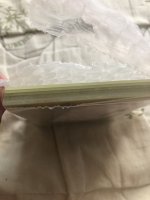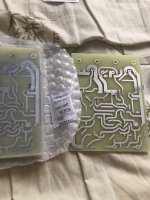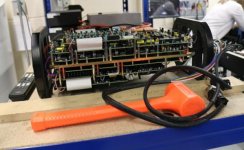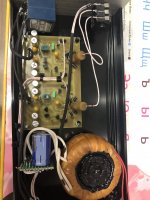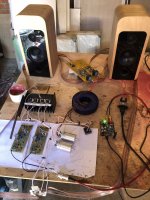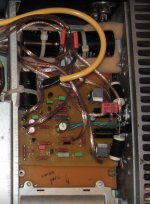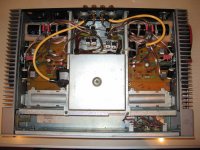I have 6qty of nap140 boards for 2scs2922 output transistors. All boards manufactures in factory.If you have boards redone, can you make two more? , I pay for it.
I like the idea of redoing a 110 or a 140 in old school epoxy pcb
This is my made design of full copy from original nap140 boards and not Chinese design (all Ali boards is not full copy )
I living in Russia how to ship this to yours country ?
Attachments
Last edited:
Dear Traderbam need listen all changed caps maybe you right maybe not 🙂) When in facility change temperature of working capacitor to High he change inside chemical electrolyte and this one change sound too. Also about Kemet ALC long life about 18000hours and +85 degrees.I’m referring to the Mundorf Mlytic AG.
Also, I’d recommend a high temperature rating, like 105°C or 125°C for a longer life.
But Mundorf is “Audiophile“ parts and more people like this audiophile sound and by this for yours devices.
how about me I‘m not like audiophile sound 🙂)
Last edited:
Given the current situation, I don't know but I'll find out and I'll let you know if I find a solution.I have 6qty of nap140 boards for 2scs2922 output transistors. All boards manufactures in factory.
This is my made design of full copy from original nap140 boards and not Chinese design (all Ali boards is not full copy )
I living in Russia how to ship this to yours country ?
I’m not sure what the “audiophile sound” is that you’ve experienced. I look for parts that are audibly invisible. I don’t want to listen to capacitors or any other hardware. Music is plenty exciting all by itself. 🙂
A challenge is knowing what causes what change in sound. Tricky. It’s a system, right, so if the rest of the system isn’t so good, putting even an ideal capacitor in it could make it sound worse. Perhaps it’s not exactly worse but differently bad. And different listeners will have different preferences for different badnesses.
A challenge is knowing what causes what change in sound. Tricky. It’s a system, right, so if the rest of the system isn’t so good, putting even an ideal capacitor in it could make it sound worse. Perhaps it’s not exactly worse but differently bad. And different listeners will have different preferences for different badnesses.
There is some good info in the NAP250 clone thread about power transistors and other parts including tants, as well as schematics...
CorrectI’m not sure what the “audiophile sound” is that you’ve experienced. I look for parts that are audibly invisible. I don’t want to listen to capacitors or any other hardware. Music is plenty exciting all by itself. 🙂
A challenge is knowing what causes what change in sound. Tricky. It’s a system, right, so if the rest of the system isn’t so good, putting even an ideal capacitor in it could make it sound worse. Perhaps it’s not exactly worse but differently bad. And different listeners will have different preferences for different badnesses.
“If yours amp is not building please use hummer…” 🤣🤣🤣🤣
Attachments
Dear Traderbam need listen all changed caps maybe you right maybe not 🙂) When in facility change temperature of working capacitor to High he change inside chemical electrolyte and this one change sound too. Also about Kemet ALC long life about 18000hours and +85 degrees.
But Mundorf is “Audiophile“ parts and more people like this audiophile sound and by this for yours devices.
how about me I‘m not like audiophile sound 🙂)
Yes, the type of capacitors will definitely influence the sound character. I agree with you 100%.
The electrolyte temperature specifications will also play a role. The higher the temperature rating (105 deg C and above) the worse the sound becomes.
Last edited:
The electrolyte temperature specifications will also play a role. The higher the temperature rating (105 deg C and above) the worse the sound becomes.
That's a very broad statement with no evidence to back it up! 🤔
Considering that many constructors are deliberately picking 105 deg C capacitors for long life in class A amplifiers I would have expected to see previous comments if there was any sound deterioration.
Please provide us with evidence, or references to support this idea.
Good day for my headamps I don’t use of 105 degrees power caps because sound with him is bad. You need just try listen 105 degrees and 85 degrees after that you choose is rightThat's a very broad statement with no evidence to back it up! 🤔
Considering that many constructors are deliberately picking 105 deg C capacitors for long life in class A amplifiers I would have expected to see previous comments if there was any sound deterioration.
Please provide us with evidence, or references to support this idea.
also Kendeil for Naim poweramps is better sound
Attachments
Last edited:
I used 105 deg C caps only once inside a class-A amp ( Aleph J)... and will never use them again.Good day for my headamps I don’t use of 105 degrees power caps because sound with him is bad. You need just try listen 105 degrees and 85 degrees after that you choose is right
also Kendeil for Naim poweramps is better sound
By the way... nice PCBs 🙂
Last edited:
Do you guys have any theories as to why you perceived worse sound quality with 105°C caps?
My understanding is that the higher the temperature rating the better the physical seal of the cans is, to reduce electrolyte evaporation rate.
My understanding is that the higher the temperature rating the better the physical seal of the cans is, to reduce electrolyte evaporation rate.
Good day how about me I just testing 105 and 85 degrees in amps and preamps and 85 degrees is better for sound for me.Do you guys have any theories as to why you perceived worse sound quality with 105°C caps?
My understanding is that the higher the temperature rating the better the physical seal of the cans is, to reduce electrolyte evaporation rate.
also I mailing to capacitors facility and ask about this range of temperatures. He say me about different electrolyte between 105 and 85 ranges. If like same resistors of characteristics but use different materials and sound is different on end devices
Last edited:
A different electrolyte? Interesting.
Did you try different voltage ratings? I understand running a cap at half its rated V could double its life expectancy.
I can accept that different electrolyte could cause different sound. Presumably an evaporation inhibitor is added. We don’t know which manufacturers use which formulas in which capacitors.
The issue you observed may not be related to temp rating in other models or other brands because they may not change the electrolyte, or not change it in the same way. It may be wrong to say all 105°C caps sound worse than all 85°C ones. But this is the sort of thing we really need to know.
Did you try different voltage ratings? I understand running a cap at half its rated V could double its life expectancy.
I can accept that different electrolyte could cause different sound. Presumably an evaporation inhibitor is added. We don’t know which manufacturers use which formulas in which capacitors.
The issue you observed may not be related to temp rating in other models or other brands because they may not change the electrolyte, or not change it in the same way. It may be wrong to say all 105°C caps sound worse than all 85°C ones. But this is the sort of thing we really need to know.
Last edited:
In 2004-2006 years I haves experience with pc motherboards and electrolytic caps and replacement works with us and few caps stay with me on to 2012 year when I see his again I little cry because all “new” caps is damage case electrolyte. But standard series of caps is good. I think the caps fabric is special make insIde caps of damage technology 🙂))A different electrolyte? Interesting.
Did you try different voltage ratings? I understand running a cap at half its rated V could double its life expectancy.
And you need do not disturb about life of caps because “all trade for die” 🙂)) this one like home lamps if you don’t by home lamps many and many employees is stay to home without money…
Last edited:
This evidence doesn't say that the difference in sound is simply is due to the electrolyte. There are other materials and manufacturing differences between brands and grades of caps that could just as easily affect their behaviour in the operating conditions of audio power amplifiers. That's why caps are specified with several more details and options like maximum DC voltage, maximum ripple current rating, ESR etc. and obvious things like dimensional proportions, terminals and vents, mounting brackets and so on.Good day how about me I just testing 105 and 85 degrees in amps and preamps and 85 degrees is better for sound for me.
also I mailing to capacitors facility and ask about this range of temperatures. He say me about different electrolyte between 105 and 85 ranges. If like same resistors of characteristics but use different materials and sound is different on end devices
So let's look at a bigger picture and more than one or two samples. Within a manufacturer's range there will be more than one grade of capacitor that has similar basic specs. of only max. DC working voltage, capacitance and 105C rating. Nichicon, for example, currently have 5 standard grades 10-33,000µF that are specified for audio applications, from standard to high quality. There are also piles of NOS (unused but usually obsolete grade stock) and some will be rated at 105C, some 85C. I suggest though, that you will find as many differences between various 105C rated brands and grades as you find between any 85C and 105C rated caps. There will also be larger differences between the obsolete grades, old stock and copies that you find cheap at Aliexpress stores. For example, I found some awful sounding (alleged) Nichicon KG caps there which I simply couldn't use, even after careful re-forming. Fakes abound!
Last edited:
You right also when you searching of components for replacement in old amps you need find maximal same with olds by sound but this task very long.This evidence doesn't say that the difference in sound is simply is due to the electrolyte. There are other materials and manufacturing differences between brands and grades of caps that could just as easily affect their behaviour in the operating conditions of audio power amplifiers. That's why caps are specified with several more details and options like maximum DC voltage, maximum ripple current rating, ESR etc. and obvious things like dimensional proportions, terminals and vents, mounting brackets and so on.
So let's look at a bigger picture and more than one or two samples. Within a manufacturer's range there will be more than one grade of capacitor that has similar basic specs. of only max. DC working voltage, capacitance and 105C rating. Nichicon, for example, currently have 5 standard grades 10-33,000µF that are specified for audio applications, from standard to high quality. There are also piles of NOS (unused but usually obsolete grade stock) and some will be rated at 105C, some 85C. I suggest though, that you will find as many differences between various 105C rated brands and grades as you find between any 85C and 105C rated caps. There will also be larger differences between the obsolete grades, old stock and copies that you find cheap at Aliexpress stores. For example, I found some awful sounding (alleged) Nichicon KG caps there which I simply couldn't use, even after careful re-forming. Fakes abound!
I see many “recaping” old Naim Naps amps and I think after “recaping” sound signature is changed.
Very interesting if you bring amps in Naim fabric and watch inside after maintenance ROE caps is still stay 🙂)
Last edited:

Posts on headphone amp split off to here:
https://www.diyaudio.com/community/...with-board-make-with-cnc.387326/#post-7047921
Logically, replacing caps 'new for old' or brand X for brandY, should change the sound you perceive. Otherwise, why would we want to replace them? Perhaps we think they should be changed like motor oil, every 6 months? Your only reference though, is likely just your memory of how the sound was maybe hours, even days before and therefore quite unreliable.
Also if you want “audiophiles” sound you needs replace all caps on Black Gate and Mundorf ZN 🤣🤣🤣🤣🤣Logically, replacing caps 'new for old' or brand X for brandY, should change the sound you perceive. Otherwise, why would we want to replace them? Perhaps we think they should be changed like motor oil, every 6 months? Your only reference though, is likely just your memory of how the sound was maybe hours, even days before and therefore quite unreliable.
But sound after that is not true Naim 🤣🤣🤣🤣🤣
In attachment my first Naim nap 140 clone made in 2009 year. PCB make with iron and laser printer 🙂)))
Attachments
Love this! Someone who judge by ear. Everybody wants 105 vs 85, more gold or expensive materials, bigger capacity in psu, better specs. Bigger, more, heavier en more expensive is always better to a lot of people in hifi. It's easier and gives certainy. But now and then somebody who can realy listen comes in with a complete contrary opinion.Good day for my headamps I don’t use of 105 degrees power caps because sound with him is bad. You need just try listen 105 degrees and 85 degrees after that you choose is right
also Kendeil for Naim poweramps is better sound
Very nice PCB's by the way.
- Home
- Amplifiers
- Solid State
- NAIM Audio NAP 110 restoration
